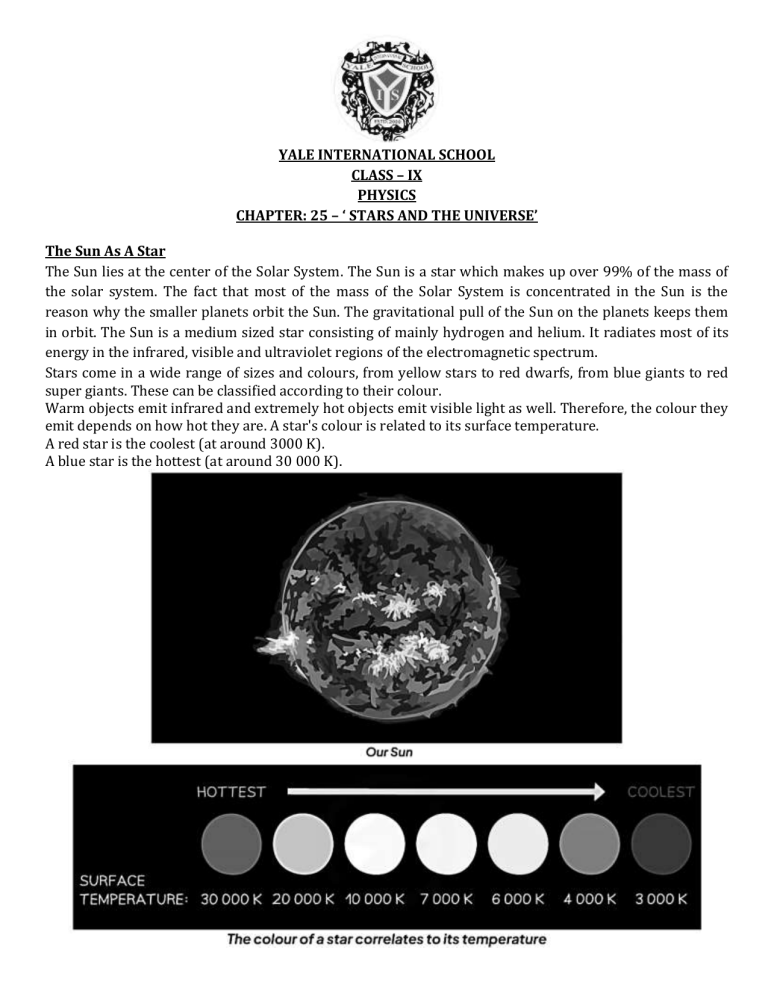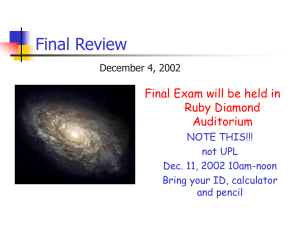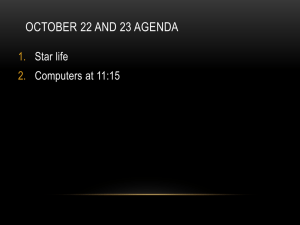
YALE INTERNATIONAL SCHOOL CLASS – IX PHYSICS CHAPTER: 25 – ‘ STARS AND THE UNIVERSE’ The Sun As A Star The Sun lies at the center of the Solar System. The Sun is a star which makes up over 99% of the mass of the solar system. The fact that most of the mass of the Solar System is concentrated in the Sun is the reason why the smaller planets orbit the Sun. The gravitational pull of the Sun on the planets keeps them in orbit. The Sun is a medium sized star consisting of mainly hydrogen and helium. It radiates most of its energy in the infrared, visible and ultraviolet regions of the electromagnetic spectrum. Stars come in a wide range of sizes and colours, from yellow stars to red dwarfs, from blue giants to red super giants. These can be classified according to their colour. Warm objects emit infrared and extremely hot objects emit visible light as well. Therefore, the colour they emit depends on how hot they are. A star's colour is related to its surface temperature. A red star is the coolest (at around 3000 K). A blue star is the hottest (at around 30 000 K). Nuclear Fusion in Stars In the center of a stable star, hydrogen atoms undergo nuclear fusion to form helium. The equation for the reaction is shown here: 2 1H + 31H → 42He + 10n A huge amount of energy is released in the reaction. This provides a pressure that prevents the star from collapsing under its gravity. The Milky Way Galaxies are made up of billions of stars. The Universe is made up of many different galaxies The Sun is one of billions of stars in a galaxy called the Milky Way. Other stars in the Milky Way galaxy are much further away from Earth than the Sun is. Some of these stars also have planets which orbit them. Astronomical distances such as the distances between stars and galaxies, are so large that physicists use a special unit to measure them called the light-year. One light-year is: The distance travelled by light through (the vacuum of) space in one year. One light year = 9.5 × 1012 km = 9.5 × 1015 m. The speed of light is the universal speed limit; nothing can travel faster than the speed of light. But over astronomical distances, light actually travels pretty slowly. The diameter of the Milky Way is approximately 100 000 light-years. This means that light would take 100 000 years to travel across it. Life Cycle of Stars 1. Nebula All stars are formed from a giant interstellar cloud of hydrogen gas and dust called a nebula. 2. Protostar The force of gravity within a nebula pulls the particles closer together until it forms a hot ball of gas, known as a Protostar. As the particles are pulled closer together, the density of the Protostar increases. This results in more frequent collisions between the particles which causes the temperature to increase. 3. Main Sequence Star Once the Protostar becomes hot enough, nuclear fusion reactions occur within its core. The hydrogen nuclei will fuse to form helium nuclei. Every fusion reaction releases heat (and light) energy which keeps the core hot. Once a Protostar is formed, its life cycle will depend on its mass. The different life cycles are shown below: 4. Red Giant or Red Super Giant After several billion years the hydrogen causing the fusion reactions in the star will begin to run out. Once this happens, the fusion reactions in the core will start to die down. This causes the core to shrink and heat up. The core will shrink because the inward force due to gravity will become greater than the outward force due to the pressure of the expanding gases as the fusion dies down. A new series of reactions will then occur around the core, for example, helium nuclei will undergo fusion to form beryllium. These reactions will cause the outer part of the star to expand. A low-mass star that is up to 8 times the mass of the Sun or smaller will become a red giant. A high-mass star that is more than 8 times the mass of the Sun will become a red super giant. It is red because the outer surface starts to cool. a) Red Giant Stars (i) Planetary Nebula Once this second stage of fusion reactions have finished, the star will become unstable and eject the outer layer of dust and gas. The layer of dust and gas which is ejected is called a planetary nebula. (ii) White Dwarf The core which is left behind will collapse completely, due to the pull of gravity, and the star will become a white dwarf. The white dwarf will cool down and as a result, the amount of energy it emits will decrease. (iii) Black Dwarf Once the star has lost a significant amount of energy it becomes a black dwarf. It will continue to cool until it eventually disappears from sight. b) Red Super Giants Stars (i) Supernova Once the fusion reactions inside the red supergiant finally finish, the core of the star will collapse suddenly causing a gigantic explosion This is called a supernova At the center of this explosion a dense body, called a neutron star will form. The outer remnants of the star will be ejected into space during the supernova explosion, forming a planetary nebula. The nebula from a supernova may form new stars with orbiting planets (ii) Neutron Star (or Black Hole) In the case of the biggest stars, the neutron star that forms at the center will continue to collapse under the force of gravity until it forms a black hole. A black hole is an extremely dense point in space from which even light cannot escape. The Universe The Milky Way is one of the millions of galaxies that make up the universe. The diameter of the Milky Way galaxy is around 100000 light years and it contains 800 billion or more stars. The Expanding Universe The fact that our Universe is expanding comes from the observations that light emitted from glowing hydrogen in the stars in the distant galaxies is shifted towards the red end of the visible light spectrum. Also the further away the galaxy from us, the greater is the red shift of the emitted light. Doppler Effect Doppler Effect refers to the change in wave frequency during the relative motion between a wave source and its observer. If the source approaches the observer, waves get crowded into a smaller space. The wavelength decreases and the frequency increases. If the source recedes the observer, waves get expanded into a larger space. The wavelength increases and the frequency decreases. The Doppler Effect shown by light waves from distant stars result in the light appearing more red indicating that the galaxies are expanding. The Big Bang If the galaxies are receding from each other it follows that there must be some point in the past when they were very close together. It is therefore possible that initially all the matter in the Universe were packed together in an extremely dense state. It is therefore believed that the Universe started about 14 billion years ago from a huge explosion called the Big Bang. Cosmic Microwave Background Radiation (CMBR) The Big Bang produced radiation energy that still exists in the Universe today in the form of cosmic microwave background radiation (CMBR) of a specific frequency. This radiation fills the whole Universe with an intensity that is nearly the same in all directions. Since the Big Bang, the Universe has expanded resulting in a redshift of the cosmic background radiation into the microwave region of the electromagnetic spectrum. Hubble’s Law And The Age Of The Universe Hubble’s law states that, “the speed of recession v of a distant galaxy is directly proportional to the distance away d”. The law can be stated as: v = Ho × d Where Ho is Hubble’s constant and is defined as the ratio of the speed at which the galaxy is moving away from the Earth to its distance from the Earth. So, it follows that Hubble’s constant is given by, 𝑣 Ho = 𝑑 The Hubble’s constant is represents the rate at which the Universe is expanding at the present time. With the limits of experimental error, the value of Hubble’s constant is estimated to have a value of 2.2 × 10 -18 per second. The age of the Universe is can be shown to be equal to equation, 𝑣 = 1 1 and can be calculated roughly from the 𝐻𝑜 . 𝑑 𝐻𝑜 From Hubble’s law it follows that, age of the universe = 1 2.2 × 10−18 = 4.5 × 1017 s But 1 year = 3.2 × 107 s So, the age of the Universe = 4.5 × 1017 s 3.2 × 107 s/year = 1.4 × 1010 years = 14 billion years.





